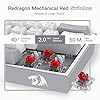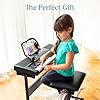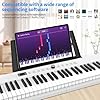Table of Contents
Learning Piano with a Focus on Sight-Reading
Learning to play the piano can be a delightful and enriching experience. One fundamental skill that enhances this journey is sight-reading. Sight-reading involves playing a piece of music from the written notation without prior familiarity. This skill is crucial for both beginners and advanced players, as it immeasurably adds to their musical versatility and understanding. Focusing on sight-reading from the outset not only speeds up the learning process but also deepens one’s musical comprehension and ability to perform diverse repertoires with confidence.
Exercise 1: Five-Finger Patterns
Begin your practice with five-finger patterns in C major. Place your right hand on the middle C, and play up to G and back down smoothly without looking at the keys. Focus on the feel of the keys and maintaining a steady tempo. Repeat this several times before switching to the left hand. This exercise helps in developing a sense of key location and improves your confidence in navigating the keyboard without sight.
Progressive Sight Reading Exercises for Piano by Hannah Smith | Sheet Music for Sight Reading Practice | Piano Technique Book for Students and Teachers | Early Intermediate Level Training Guide
John Kember: Piano Sight-Reading Volume 1 A Fresh Approach | Beginner to Intermediate Sight Reading Method | Self-Learning Piano Book | Educational Sheet Music Songbook for Daily Practice
Improve Your Sight-reading! Piano, Level 1: A Progressive, Interactive Approach to Sight-reading (Faber Edition: Improve Your Sight-Reading)
$6.95 (as of December 13, 2025 23:10 GMT -08:00 - More infoProduct prices and availability are accurate as of the date/time indicated and are subject to change. Any price and availability information displayed on [relevant Amazon Site(s), as applicable] at the time of purchase will apply to the purchase of this product.)Sight Reading Mastery for Guitar: Unlimited reading and rhythm exercises in all keys (Learn guitar theory and technique)
$8.99 (as of December 13, 2025 23:48 GMT -08:00 - More infoProduct prices and availability are accurate as of the date/time indicated and are subject to change. Any price and availability information displayed on [relevant Amazon Site(s), as applicable] at the time of purchase will apply to the purchase of this product.)Exercise 2: Simple Melodies
Practice playing simple melodies from children’s songs or basic exercises from beginner piano books. Read one note at a time and try to play without looking at your hands. This reinforces the connection between reading the music and executing the notes, which is crucial for sight-reading. Start with very short pieces or even single phrases, emphasizing accuracy and rhythmic integrity.
Exercise 3: Rhythm Reading
Focusing on reading and executing rhythms is another vital aspect of sight-reading. Clap out different rhythms you see on sheet music before attempting to play them on the piano. Use a metronome to ensure you’re keeping time accurately. Gradually combine these rhythms with notes, starting with simple ones. The goal here is to develop rhythmic precision while sight-reading.
Exercise 4: Interval Recognition
Work on recognizing intervals on sight. Start by identifying them in written music and name them out loud. Then, play those intervals on the piano. Move from smaller intervals like seconds and thirds to larger ones like fifths and octaves. Understanding and recognizing intervals quickly is fundamental to proficient sight-reading as it allows you to play more notes with fewer glances at the keyboard.
Exercise 5: Incorporating Dynamics and Articulations
Begin to include dynamics (loudness or softness of the music) and articulations (how notes are played, e.g., staccato or legato) in your sight-reading practice. Start with a simple piece you are comfortable with and focus on applying dynamic and articulation markings exactly as written. This practice helps you interpret and execute more complex textures and expressions in sight-reading periods.
Redragon Mechanical Gaming Keyboard Wired, 11 Programmable Backlit Modes, Hot-Swappable Red Switch, Anti-Ghosting, Double-Shot PBT Keycaps, Light Up Keyboard for PC Mac
40% OffLogitech K270 Wireless Keyboard for Windows, 2.4 GHz Wireless, Full-Size, Number Pad, 8 Multimedia Keys, 2-Year Battery Life, Compatible with PC, Laptop, Black
33% OffRedragon K617 Fizz 60% Wired RGB Gaming Keyboard, 61 Keys Hot-Swap Compact Mechanical Keyboard w/White and Grey Color Keycaps, Linear Red Switch, Pro Driver/Software Supported
$44.99 (as of December 13, 2025 16:23 GMT -08:00 - More infoProduct prices and availability are accurate as of the date/time indicated and are subject to change. Any price and availability information displayed on [relevant Amazon Site(s), as applicable] at the time of purchase will apply to the purchase of this product.)EPOMAKER x Aula F75 Gasket Mechanical Keyboard, 75% Wireless Hot Swappable Gaming Keyboard with Five-Layer Padding&Knob, Bluetooth/2.4GHz/USB-C, RGB (Light Blue, LEOBOG Reaper Switch)
15% OffExercise 6: Chord Recognition and Playing
Identify and play chords encountered in music pieces. Start with major and minor triads, and gradually progress to more complex chords. For efficient practice, look at a piece, identify all chords by sight, and then play through them focusing on smooth transitions between chords. This helps in developing an understanding of harmonic structure which is critical for advanced sight-reading skills.
Exercise 7: Daily Review
End each practice session by playing a new, short piece of music as a sight-reading test. Record your performance to evaluate your fluency, accuracy, and rhythmic integrity. Make this a regular part of your daily practice routine to measure your progress and identify areas needing more focus.
How to Read and Interpret Sheet Music Quickly
Mastering sight-reading requires a methodical approach to both reading and interpreting sheet music efficiently. Here are detailed approaches to improving these skills:
1. Familiarize Yourself with the Basics
Start by understanding the fundamental elements of sheet music. This includes the staff, clefs (treble and bass), and the note values. Ensure you know how these notes correspond to your piano keys. A quick recognition of these basics is crucial for sight-reading.
2. Learn to Identify Key Signatures and Time Signatures
Key signatures are essential as they determine the scale of the piece, which ultimately affects the accidentals you’ll expect to encounter. Time signatures are critical as well—they dictate the rhythm and beat structure of the composition. Memorize the common key and time signatures to read music more swiftly.
3. Practice Interval Reading Instead of Note-by-Note
Reading intervals (the distance between notes) rather than individual notes can speed up your sight-reading. Recognize patterns in the intervals to quickly anticipate the next note’s position relative to the previous one. This technique allows for faster internalization and reaction time when playing.
4. Incorporate Rhythmic Reading
Focus on the rhythmic patterns within your sheet music. Practicing different rhythm combinations separately can help you understand and execute them more effortlessly when sight-reading. Clapping out rhythms before playing them on the piano is an effective practice technique.
5. Use Visual Anchor Points
Create visual anchor points in the music. Look for repetitions, familiar phrases, or chords and use them as recovery spots during your reading. These anchors can provide quick checkpoints to regain your bearings if you get lost.
6. Practice with A Variety of Music Pieces
Exposing yourself to a wide range of music genres and compositions enlarges your familiarity and versatility, which in turn enhances your sight-reading proficiency. Include both simple and complex pieces in your training routine.
7. Develop Hand-Eye Coordination
Enhancing your hand-eye coordination through regular practice is vital. The goal is to reduce the time it takes for your brain to translate written notes into hand movements. Drills that require you to play without looking at your hands can significantly improve this skill.
8. Regular Sight-Reading Practice
Incorporate dedicated sight-reading sessions into your daily practice routine. Start with simpler pieces and gradually increase the difficulty. It’s important to explore different key signatures, rhythms, and styles to challenge your reading capacity.
9. Analyze and Learn from Mistakes
Review your sight-reading sessions and pinpoint where you faced difficulties. Understanding the mistakes—whether they’re rhythm, intervals, or note misreads—will guide your practice sessions and help prevent similar errors in the future.
10. Engage in Mental Practice
Away from the piano, visualize playing the piece in your mind. Read through the sheet music and imagine your fingers moving on the piano. This mental exercise can reinforce physical habits and conceptual understanding.
Tips for Improving Sight-Reading Speed on Piano
Using Flashcards to Memorize Key Signatures
When learning piano with a focus on sight-reading, memorizing key signatures is fundamental. Using flashcards is a highly effective method to achieve this. Here’s how you can maximize this technique:
Each flashcard should feature one key signature on the front and the name of the key on the back. Include both major and minor keys to ensure thorough understanding. It’s beneficial to use different colors for major and minor keys to help with visual differentiation.
Consistency is key when using flashcards. Set aside specific times each day for flashcard review. Even short sessions, such as 10-15 minutes, can dramatically improve your memory of key signatures if done regularly.
Review each flashcard by first trying to recall the key signature without looking at the answer. This active recall method strengthens memory retention far more effectively than passive review.
Use a spaced repetition system, where flashcards you find difficult are reviewed more frequently than those you know well. This method adapts to your learning pace and is proven to enhance the memorization process.
To avoid forming patterns and to simulate the randomness you would encounter in sheet music, shuffle the flashcards regularly. This prevents the memorization of the order of cards and focuses on truly learning the key signatures.
Combine flashcard sessions with actual piano practice. After reviewing a key signature, play a scale or a piece in that key to reinforce the association between the visual key signature and the corresponding piano keys.
Practicing with New Pieces to Enhance Sight-Reading
One effective way to improve your piano sight-reading skills is to continually introduce new pieces into your practice routine. This not only broadens your exposure to different musical styles and structures but also challenges you to adapt quickly to unfamiliar music. Here’s a detailed look at how to effectively use new pieces for sight-reading enhancement:
Start by selecting pieces that are just slightly above your current reading ability. This keeps the challenge level manageable, preventing frustration while still pushing your skills forward. It’s essential to choose a variety of genres and composers to cover a broader spectrum of musical notation and phrasing.
On your first read-through, don’t worry about playing mistakes. Focus primarily on maintaining a steady tempo. Your goal here is to understand the piece’s overall structure, key signatures, and any potential difficulties like complex rhythms or fast passages. Mark sections that may require extra attention.
After identifying tricky areas, slow down. This is crucial for building muscle memory and accuracy without the pressure of full speed. Gradually increase your tempo as you become more comfortable with the notes and rhythms.
Pay special attention to maintaining rhythmic integrity. Often, rhythmic mistakes can throw off your entire performance more significantly than wrong notes. Use a metronome to keep yourself in check and to help internalize the rhythmic structure.
After spending time with the piece, return to it to see how much smoother your reading has become. Reflect on what elements remain challenging and consider revisiting those in separate supplementary exercises.
Occasionally, record yourself playing. Listening back can offer a new perspective on your sight-reading progress. You might notice things while listening that you didn’t catch during playing, such as subtle rhythmic discrepancies or dynamic imbalances.
Consistency is key in making sustained progress in sight-reading. Aim to introduce new pieces regularly; for example, integrating a new piece every week. This frequent change of repertoire prevents you from becoming overly familiar with any one piece, which is critical for sight-reading practice.
Conclusion: Mastering Piano Through Proficient Sight-Reading
In conclusion, achieving proficiency in sight-reading is integral to mastering the piano. It enhances the ability to play new compositions with ease and accuracy, accelerates learning, and fosters a deeper understanding of musical theory and construction. Dedicated practice, starting with simpler pieces and gradually increasing complexity, is essential. Utilizing a variety of resources and tools, including digital applications and metronomes, can significantly aid in this learning process. Ultimately, the discipline and skills developed through focused sight-reading practice not only improve piano performance but also enrich one’s overall musical experience.


























































